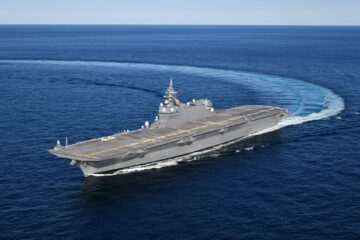The defense ministry plans to begin construction of the first ship in the next fiscal year, and had requested 379.7 billion yen in a defense budget request on August 31.
It emphasized that the final budget for the construction of ASEV is almost the same as requested because Defense Minister Minoru Kihara met with Finance Minister Shunichi Suzuki to discuss the matter on December 19.
In a press release following today’s ministerial-level negotiations, the defense ministry specifically said that 373.1 billion yen as construction costs of the two ASEV was allocated on the two promises:
- (1) it will aim to build an effective project management system ;
- (2) when acquiring and updating Aegis destroyers in the future, such as updating the Kongo-class Aegis destroyers, it will take a zero-based review regarding the selection of to-be-installed radars (for successors to the Kongo-class ships).
The defense ministry has selected Lockheed Martin AN/SPY-7 solid-state radars (SSRs) on the two ASEV over Raytheon’s AN/SPY-6 radar, which was originally designed for US Navy warships equipped with the Aegis Combat System. Meanwhile, Japan’s four Kongo-class destroyers use Lockheed Martin’s AN/SPY-1.
“It is necessary to keep in mind that the situation with new ASEV’s radars will have an impact on the future status of the Maritime Self-Defense Force’s Aegis ships, such as the renewal of the Kongo-class Aegis ships, and to pay close attention to interoperability with the US Navy,” the finance ministry’s document in October said, suggesting the nation’s future Aegis destroyers use the AN/SPY-6 radar.
The Japanese defense ministry also said:
“In order to fundamentally strengthen our defense capabilities, we will flexibly consider and scrutinize the contents of projects, taking into account the security environment, exchange rates, and price conditions, and strive for further efficiency and rationalization within the scope of ‘about 43 trillion yen’ set in the Defense Buildup Plan,”
The ASEV are positioned as the cornerstone of Japan’s missile defense, particularly keeping in mind the ballistic missile threat from North Korea.
In late August, the defense ministry explained that the new ships will be 190 meters long, 25 meters wide, and have a standard displacement of 12,000 tons. In comparison, the two Maya-class Aegis-equipped destroyers are 170 meters long, 21 meters wide, and have a standard displacement of 8,200 tons.

The ministry pointed out that the size of the ASEV will be 1.7 times larger than the US Navy’s latest Flight III Arleigh Burke-class guided-missile destroyer.
The ASEV will have a crew complement of about 240, which is much fewer than the Maya-class destroyer’s 300 crewmembers.
The Japanese Maritime Self-Defense Force (JMSDF) is expected to take delivery of the first ASEV during fiscal year 2027, with the second one in the following fiscal year.
The ministry expects the total construction cost for each vessel to reach about 395 billion yen as of late August.
As previously reported by Naval News, the configuration of the main armament used by the ASEV is similar to that of two Maya-class ships, including a Mk-45 (Mod.4) 5-inch/62-caliber (127mm) main gun, SM-3 Block IIA and SM-6 missiles.
The defense ministry said the new ships will be equipped with weapon systems such as a long-range, ship-launched, improved version of the Type 12 Surface-to-Ship Missile (SSM), U.S.-made Tomahawk cruise missiles, and high-power anti-drone laser systems starting from fiscal year 2032.
In comparison, the latest U.S. Arleigh Burke-class Aegis destroyer (DDG-51 class), in the case of Flight III, the latest estimate for 2023 is $2 billion (about 290 billion yen) per ship. It is an Aegis destroyer with a fully loaded displacement of 9,500 tons equipped with the new SPY-6 radar.
Japan’s Fumio Kishida cabinet plans to approve the government budget draft for fiscal 2024 on December 22, including the whole defense budget plan.






